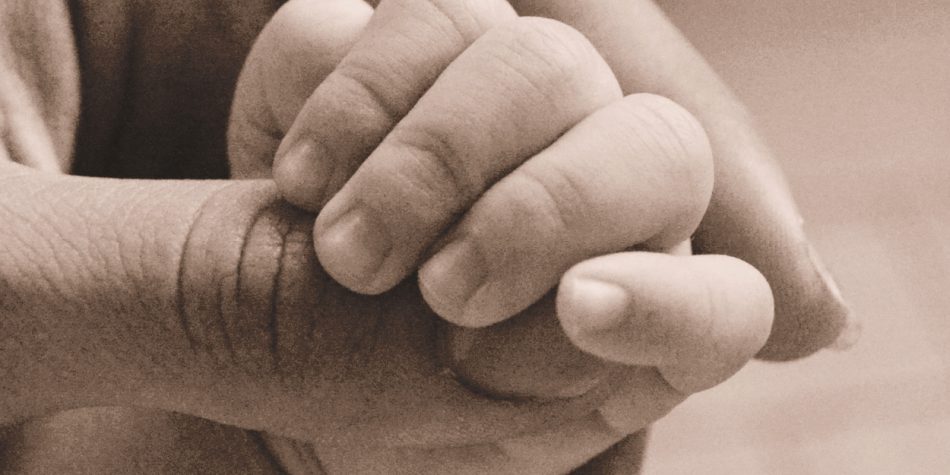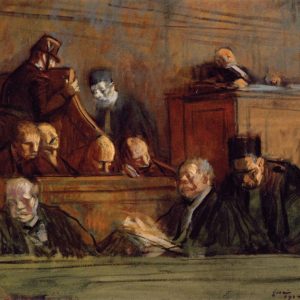The debate over abortion is so often reduced to simple stereotypes and slogans. There is so much high emotion on both sides, and the debate is frankly exhausting. But despite the emotional intensity of the issue, I think most of us intuitively recognize problems with either the most extreme pro-life position (that a fertilized egg from the moment of conception is absolutely equal in value to an adult life and that terminating any egg is the equivalent of murder), or the most extreme pro-choice position (that a child can be terminated at anytime up to the point of delivery for any reason – or even after delivery in the reprehensible thinking of Peter Singer). Something tells us that there is something facile or overly simplistic about both of these positions.
As I have been discussing and defending the pro-life position with friends in recent weeks and months, I have been trying to understand the moral underpinnings of the pro-life (and conversely the pro-choice position) a little bit better. I have come to see that there are at least four core pillars that undergird what I see as the strength of the pro-life position. In certain circumstances, one or two of these pillars will be missing or less forcefully present. In such circumstances, the pro-life position is a bit more tenuous. And it is on these interstitial grounds where Americans seem to instinctively favor some forms of exceptions or exemptions when it comes to the allowance of abortion.
These are the four pillars of the pro-life position that I have identified.
- The child is a human life, entitled to protection.
- The Embryo, if left unimpeded, will grow into a human life.
- While acknowledging tragic and violent exceptions, the mother exercised her moral agency and took action which led to the development of human life.
- The birth of the child will not generally result in serious harm to the mother.
I want to illustrate each of these four pillars at work using quotes from President Russell Nelson’s iconic sermon, Abortion: An Assault on the Defenseless. I will then discuss situations where that particular pillar is weakened or absent and how that impacts the moral case against abortion. Before I start, however, I want to note that these are solely my thoughts and do not represent my Church or my employer.
1) The Child is a human life, entitled to protection.
Here is President Nelson succinctly expressing this point:
“In the course of my studies as a medical doctor, I learned that a new life begins when two special cells unite to become one cell, bringing together 23 chromosomes from the father and 23 from the mother. These chromosomes contain thousands of genes. In a marvelous process involving a combination of genetic coding by which all the basic human characteristics of the unborn person are established, a new DNA complex is formed. A continuum of growth results in a new human being. Approximately 22 days after the two cells have united, a little heart begins to beat. At 26 days the circulation of blood begins. To legislate when a developing life is considered ‘meaningful’ is presumptive and quite arbitrary, in my opinion.”
In my judgment this is the most unassailable of the four pillars, as it is definitionally always the case with any viable pregnancy. That embryo in the womb is in every way a unique human being with his or her own genetic structure, organs, blood type, etc. And this is foundationally true from the moment of conception, at least with regard to DNA.
Some might argue that this pillar is absent in cases of serious fetal abnormality, such that the child will almost certainly not live a happy or normal life. But as President Nelson explained, “Life has great value for all, including those born with disabilities.” And refusing to acknowledge this point moves down the slippery slope that has led to some of the greatest evils of human history from eugenics to genocide:
“To deny life to an individual because of a possible handicap is a very serious matter. Policy consistent with that logic would dictate that those already living with such deficiencies should likewise be terminated. One more step in that tragic train of thought would lead to the conclusion that those who are either infirm or inconvenient should also be eliminated. Such irreverence for life would be totally unthinkable!”
This is the pillar that the most simplistic pro-life slogans most typically rest upon. But the problem with resting on this pillar alone is that it fails to acknowledge that a pregnant mother is also a person with a claim to bodily integrity alongside other liberty interests. When we are talking about abortion bans, we are discussing a state-imposed prohibition that tells a woman that she must subordinate her interests to that of a child. So I don’t think this pillar standing alone does enough to answer the question of why the State could be justified in requiring a woman to carry a child to term.
2) The Embryo if left unimpeded will grow into a fully human life.
This is often the unstated but implied corollary to the first pillar. Once an embryo is implanted and past the initial stages of pregnancy, the woman’s body will kick into gear and produce all of the conditions needed to deliver a human child. Thus, if no action is taken to impede the pregnancy, most pregnancies will result in the development and delivery of a child. Accordingly, taking action to intervene in and terminate that process is harmful and immoral, particularly when done by a medical professional that has taken an oath to do no harm. If the pregnancy truly is futile there is less moral reason to compel a woman to bear harmful and unpleasant side effects for nought.
There are a few cases where this pillar is weaker or absent:
First of all, in the case of in vitro fertilization, eggs are fertilized outside of the womb. If those eggs are never placed back inside of the woman, then they will never be on that track towards developing into a child. This is one of the reasons that it appears to me that the moral case for IVF is stronger than the moral case for an abortion. There is, of course, another even more obvious reason that IVF is morally permissible. That procedure is undertaken not for the purpose of terminating life, but for the purpose of helping a couple that could not otherwise get pregnant to bring a child to the world. As such, IVF is the opposite of an abortion procedure in its aims and purpose.
Second, it may be apparent that a child will not, in fact, ever survive the pregnancy. For instance, a baby’s skull may not be formed properly which will guarantee that a child will not live outside the womb. Severe life threatening fetal abnormalities also fall into this category. In such circumstances, the moral case for an abortion is stronger. If the pregnancy truly is futile there is less moral reason to compel a woman to bear harmful and unpleasant side effects for nought.
However, President Nelson’s offers a well-needed warning about abortion in these circumstances: “Some argue for abortion because of fear that a child may have a congenital malformation. Surely the harmful effects of certain infectious or toxic agents in the first trimester of pregnancy are real, but caution is needed in considering the termination of a pregnancy. Life has great value for all, including those born with disabilities. Furthermore, the outcome may not be as serious as postulated.” And President Nelson cements this principle with a powerful story of a couple who had faith to have a child even though the child had been diagnosed with disabilities.
But in such circumstances, medical experts rather than government officials are the best arbiters of the seriousness of a medical crisis. So abortion should logically be legal in at least such circumstances. This is consistent with the Church policy described by President Nelson: “Current policy now includes [an] exception[] … if the baby cannot survive beyond birth, as determined by competent medical counsel.”
We might also briefly consider a consequentialist argument on this point. If we hope to encourage child-birth and child rearing, then forcing a parent to carry a child to term when it is practically certain that the child will die after birth fails to achieve this goal. Parents in these circumstances often desperately want a child. It may be far better to allow for the termination of a failed pregnancy and to allow parents to try again. Otherwise, the emotional and physical stigma of carrying a stillborn child to full term may discourage these very deserving and desirous parents from having the child they want.
One final point on this pillar. It is this pillar that makes the case against late-term abortions particularly strong. When a child could, by the matter of due course, be delivered and survive outside of the womb, then it is particularly cruel or unjust to take steps to terminate rather than deliver the child. And I suspect that the appeal of this argument is what led the Supreme Court to adopt a viability standard in Planned Parenthood v Casey despite all of the scientific problems with viability as a threshold.
3) While acknowledging tragic, and violent exceptions, the mother exercised her moral agency and took action which led to the development of human life.
This principle is perhaps the most controversial out of the ones I highlight. Some would argue that the very idea of ascribing agency and choice to a pregnancy that was not “planned” is judgmental and patriarchal.
But I find President Nelson’s response to that argument to be quite persuasive:
Elective abortion has been legalized in many countries on the premise that a woman is free to choose what she does with her own body. To an extent this is true for each of us, male or female. We are free to think. We are free to plan. And we are free to do. But once an action has been taken, we are never free from its consequences.
To understand this concept more clearly, we can learn from the astronaut. Anytime during selection or preparation, he or she is free to withdraw from the program. But once the spacecraft has lifted off, the astronaut is bound to the consequences of the previous choice to make the journey.
So it is with people who choose to embark on a journey that leads to parenthood. They have freedom of choice—to begin or not to begin that course. When conception does occur, that choice has already been made.
Yes, a woman is free to choose what she will do with her body. Whether her choice leads to an astronaut’s mission or to a baby, her choice to begin the journey binds her to the consequences of that choice. She cannot ‘unchoose.’
As President Nelson explains, we ultimately choose the consequences of our actions. Therefore an ordinary pregnancy is chosen even if the outcome was not a desired one.
There appears to me to be two deviations from this norm. The first is a situation where a form of birth control fails and results in an unanticipated pregnancy. A couple may have done everything possible to minimize the chances of a pregnancy to less than 1%, and yet a pregnancy unexpectedly results. This does not appear to me to be a serious challenge to President Nelson’s claim. Perhaps the odds of pregnancy were very low, but when one voluntarily engages in an inherently procreative act, one is aware of the possibility of pregnancy and accepting the possibility of that consequence. Because the woman’s freedom of choice was denied, it intuitively feels wrong to require her to bear the consequences of something that was thrust upon her.
The situation of rape is a far more compelling example of the absence of this pillar. When force is used to compel a woman to engage in unwanted sex, then it cannot be said that a woman has used any form of moral agency to choose to enter into a pregnancy.
As President Nelson explained:
Another concern applies to pregnancies resulting from rape or incest. This tragedy is compounded because an innocent woman’s freedom of choice was denied. In these circumstances, abortion is sometimes considered advisable to preserve the physical and mental health of the mother.
Because the woman’s freedom of choice was denied, it intuitively feels wrong to require her to bear the consequences of something that was thrust upon her. The case of a rape most closely resembles the famous hypothetical of the “violinist” where a woman wakes up attached to a famous violinist who will die if the woman unplugs from him.
The counter-argument is that a second tragedy (an abortion) does not right the first tragedy. This is a good moral argument, but I am doubtful that it makes good public policy. We should of course praise women who make the difficult choice to keep a child after a rape. But I am skeptical that women in these circumstances should be forced to carry a child that is the product of rape because of how this compounds the tragedy and trauma of the rape. For this reason, I am among many the pro-life advocates who support a rape exception to abortion. But I also recognize that this is a difficult moral issue and that many of my pro-life friends will disagree.
4) The birth of the child will not generally result in serious harm to the mother.
With any ordinary pregnancy, there is always some risk of pregnancy-related complications. And of course, delivery is itself painful and emotionally draining. But the number of deaths due to childbirth is actually quite small. The CDC estimates that about 700 women a year die in the whole United States from pregnancy related complications. Now that number is a lot higher than it probably should be. But it is still only .01% of the nearly 4,000,000 births in the United States. Given the extremely positive prognosis for pregnancy, it seems morally reasonable to require a woman to bear the difficulties of pregnancy in order to save the life of a separate human child.
But that is clearly not the case in a pregnancy when there is serious risk to the life of the mother.
Of course, as President Nelson explained, such circumstances are uncommon: “Concern for the health of the mother is a vital one. But circumstances in which the termination of pregnancy is necessary to save the life of the mother are very rare, particularly where modern medical care is available.”
Still, when there is a risk that a woman might die as a result of a pregnancy or suffer permanent and serious physical injury, the case for an abortion is compelling. Indeed, it would seem unjust in such circumstances to require a woman to sacrifice her life to deliver a child (who may or may not survive the pregnancy). To the contrary, there may be an affirmative right to preserve a mother’s life in such circumstances, which not only should be protected but must be protected.
On the other hand, many states today employ an exceptionally broad definition of “health” to encompass practically any and all physical or mental discomfort. Such a broad exception for the “health” of the mother essentially swallows the rule and cannot be justified.
This isn’t to say that pregnancy-related problems such as the financial burden surrounding a pregnancy or parenthood are not significant. It is especially important to recognize the difficulty and challenge that comes from raising a child with a condition such as down syndrome. We should not ignore the emotional (not to mention the financial) toll that comes from taking care of a child who may be dependent throughout his or her life. Pro-life people may at times be too casual or too dismissive about the challenges that a pro-life position would result in.
Indeed, those of us who are pro-life should feel some obligation to improve conditions of pregnancy and build up a stronger foundation of support for those who may not have planned for or wanted a child. We should do whatever we can to make adoption easy, painless, and stigma-free. We should invest resources to improve child welfare and foster care systems. Somewhat more controversially, I believe we should also make birth control and other forms of contraception that do not require an abortion widely available. If we are willing to use the force of the state to compel a woman to keep a pregnancy, then we must be also prepared to use our wealth for the benefit of those who are impacted by these laws.
A common criticism of the pro-life position is that those who are pro-life only support life until birth and not afterwards. This is in many ways an unfair stereotype. As a whole, pro-life individuals tend to be religious and strongly supportive of religious, philanthropic, and community charitable causes but more skeptical of government social programs. Still, it does seem to me that we need to carefully evaluate our policy positions to make sure that we are not taking positions that impose extra burdens on women who do carry an unexpected or unplanned child to term. As long as abortion remains legal, it appears to me that these are some of the more effective policies that we can advance to reduce the abortion rate. And if abortion is more heavily restricted (and I pray that it will be), then we will need to step up and do a lot more to protect, support, and encourage life.
But even though it is fair to argue that pro-life people could be doing more to champion these policies which promote life, that does not challenge or undermine the strong moral foundations of the pro-life position. And President Nelson’s prophetic talk illustrates powerfully the moral necessity to stand up for life.



















